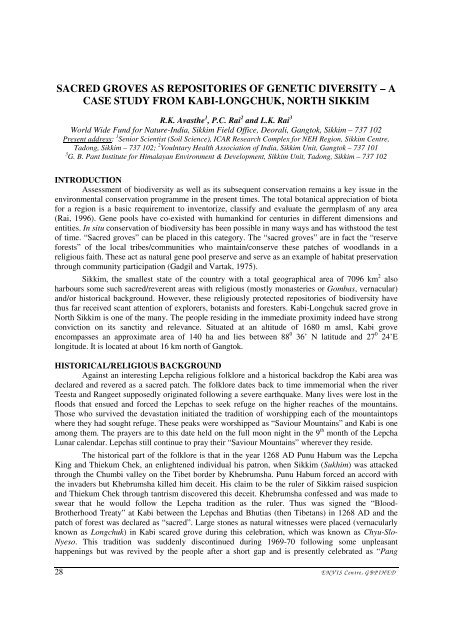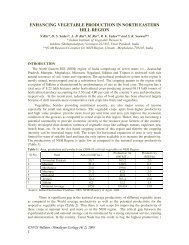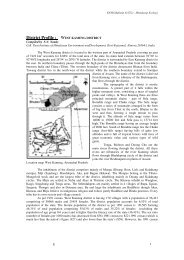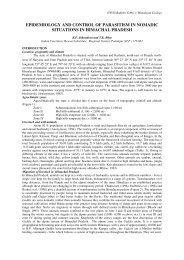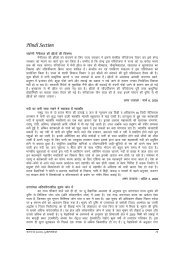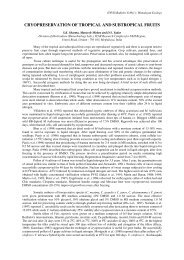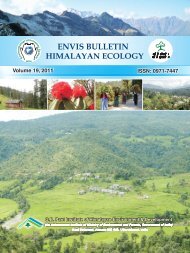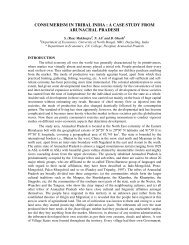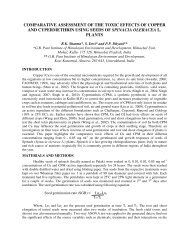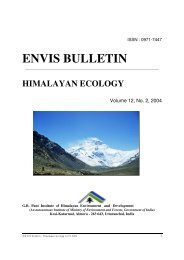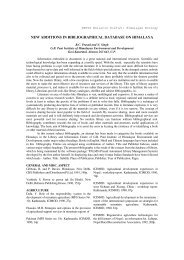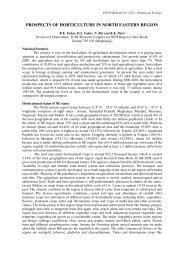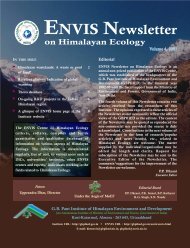Envis bulletin vol 12 1 - ENVIS Centre on Himalayan Ecology
Envis bulletin vol 12 1 - ENVIS Centre on Himalayan Ecology
Envis bulletin vol 12 1 - ENVIS Centre on Himalayan Ecology
Create successful ePaper yourself
Turn your PDF publications into a flip-book with our unique Google optimized e-Paper software.
SACRED GROVES AS REPOSITORIES OF GENETIC DIVERSITY – A<br />
CASE STUDY FROM KABI-LONGCHUK, NORTH SIKKIM<br />
R.K. Avasthe 1 , P.C. Rai 2 and L.K. Rai 3<br />
World Wide Fund for Nature-India, Sikkim Field Office, Deorali, Gangtok, Sikkim – 737 102<br />
Present address: 1 Senior Scientist (Soil Science), ICAR Research Complex for NEH Regi<strong>on</strong>, Sikkim <str<strong>on</strong>g>Centre</str<strong>on</strong>g>,<br />
Tad<strong>on</strong>g, Sikkim – 737 102; 2 Voulntary Health Associati<strong>on</strong> of India, Sikkim Unit, Gangtok – 737 101<br />
3 G. B. Pant Institute for <strong>Himalayan</strong> Envir<strong>on</strong>ment & Development, Sikkim Unit, Tad<strong>on</strong>g, Sikkim – 737 102<br />
INTRODUCTION<br />
Assessment of biodiversity as well as its subsequent c<strong>on</strong>servati<strong>on</strong> remains a key issue in the<br />
envir<strong>on</strong>mental c<strong>on</strong>servati<strong>on</strong> programme in the present times. The total botanical appreciati<strong>on</strong> of biota<br />
for a regi<strong>on</strong> is a basic requirement to inventorize, classify and evaluate the germplasm of any area<br />
(Rai, 1996). Gene pools have co-existed with humankind for centuries in different dimensi<strong>on</strong>s and<br />
entities. In situ c<strong>on</strong>servati<strong>on</strong> of biodiversity has been possible in many ways and has withstood the test<br />
of time. “Sacred groves” can be placed in this category. The “sacred groves” are in fact the “reserve<br />
forests” of the local tribes/communities who maintain/c<strong>on</strong>serve these patches of woodlands in a<br />
religious faith. These act as natural gene pool preserve and serve as an example of habitat preservati<strong>on</strong><br />
through community participati<strong>on</strong> (Gadgil and Vartak, 1975).<br />
Sikkim, the smallest state of the country with a total geographical area of 7096 km 2 also<br />
harbours some such sacred/reverent areas with religious (mostly m<strong>on</strong>asteries or Gombas, vernacular)<br />
and/or historical background. However, these religiously protected repositories of biodiversity have<br />
thus far received scant attenti<strong>on</strong> of explorers, botanists and foresters. Kabi-L<strong>on</strong>gchuk sacred grove in<br />
North Sikkim is <strong>on</strong>e of the many. The people residing in the immediate proximity indeed have str<strong>on</strong>g<br />
c<strong>on</strong>victi<strong>on</strong> <strong>on</strong> its sanctity and relevance. Situated at an altitude of 1680 m amsl, Kabi grove<br />
encompasses an approximate area of 140 ha and lies between 88 0 36’ N latitude and 27 0 24’E<br />
l<strong>on</strong>gitude. It is located at about 16 km north of Gangtok.<br />
HISTORICAL/RELIGIOUS BACKGROUND<br />
Against an interesting Lepcha religious folklore and a historical backdrop the Kabi area was<br />
declared and revered as a sacred patch. The folklore dates back to time immemorial when the river<br />
Teesta and Rangeet supposedly originated following a severe earthquake. Many lives were lost in the<br />
floods that ensued and forced the Lepchas to seek refuge <strong>on</strong> the higher reaches of the mountains.<br />
Those who survived the devastati<strong>on</strong> initiated the traditi<strong>on</strong> of worshipping each of the mountaintops<br />
where they had sought refuge. These peaks were worshipped as “Saviour Mountains” and Kabi is <strong>on</strong>e<br />
am<strong>on</strong>g them. The prayers are to this date held <strong>on</strong> the full mo<strong>on</strong> night in the 9 th m<strong>on</strong>th of the Lepcha<br />
Lunar calendar. Lepchas still c<strong>on</strong>tinue to pray their “Saviour Mountains” wherever they reside.<br />
The historical part of the folklore is that in the year <str<strong>on</strong>g>12</str<strong>on</strong>g>68 AD Punu Habum was the Lepcha<br />
King and Thiekum Chek, an enlightened individual his patr<strong>on</strong>, when Sikkim (Sukhim) was attacked<br />
through the Chumbi valley <strong>on</strong> the Tibet border by Khebrumsha. Punu Habum forced an accord with<br />
the invaders but Khebrumsha killed him deceit. His claim to be the ruler of Sikkim raised suspici<strong>on</strong><br />
and Thiekum Chek through tantrism discovered this deceit. Khebrumsha c<strong>on</strong>fessed and was made to<br />
swear that he would follow the Lepcha traditi<strong>on</strong> as the ruler. Thus was signed the “Blood-<br />
Brotherhood Treaty” at Kabi between the Lepchas and Bhutias (then Tibetans) in <str<strong>on</strong>g>12</str<strong>on</strong>g>68 AD and the<br />
patch of forest was declared as “sacred”. Large st<strong>on</strong>es as natural witnesses were placed (vernacularly<br />
known as L<strong>on</strong>gchuk) in Kabi scared grove during this celebrati<strong>on</strong>, which was known as Chyu-Slo-<br />
Nyeso. This traditi<strong>on</strong> was suddenly disc<strong>on</strong>tinued during 1969-70 following some unpleasant<br />
happenings but was revived by the people after a short gap and is presently celebrated as “Pang<br />
28<br />
E N V IS <str<strong>on</strong>g>Centre</str<strong>on</strong>g>, G B P IH E D


